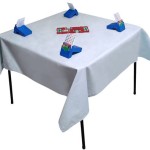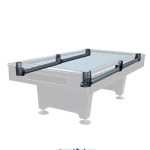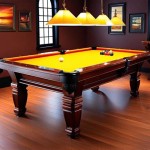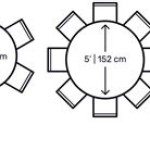Standard Kitchen Table Height: A Comprehensive Guide
The kitchen table serves as a central hub in many homes. It's a place for meals, homework, socializing, and even work. Ensuring the table is at a comfortable and functional height is crucial for its usability and overall impact on the kitchen environment. Understanding standard kitchen table height allows for informed decisions when buying, building, or modifying a table. It promotes proper posture, reduces strain, and enhances the overall dining and working experience.
This article explores the standard height of a kitchen table, delving into the various factors influencing this measurement and offering valuable insights for creating a comfortable and functional kitchen space. It will cover the history of these dimensions, variations based on design and purpose, and considerations for accommodating different seating arrangements.
Understanding the Standard Dimensions
The universally accepted standard height for a kitchen table falls between 28 and 30 inches (71-76 centimeters) from the floor to the top of the table surface. This measurement is designed to accommodate the majority of adults comfortably while dining or engaging in other activities. This height aligns with typical dining chair heights, facilitating proper posture and minimizing strain on the back and arms.
The rationale behind this specific height is rooted in ergonomic principles and human anthropometry, the study of human body measurements. Decades of observations and studies have determined that this range allows for a natural arm position when seated, preventing hunching or straining to reach the tabletop. This standardized height promotes a comfortable and sustainable posture for extended periods of use.
While the 28-30 inch range is the standard, it's important to note potential minor variations. Some tables might be slightly shorter or taller, accommodating specific design features or catering to particular preferences. However, deviating significantly from this standard can lead to ergonomic issues and reduced comfort levels.
Factors Influencing Table Height Selection
Several factors warrant consideration when determining the ideal kitchen table height for a specific space. These factors include the primary intended use of the table, the height of the individuals who will primarily use the table, the style of seating intended to be used with the table, and the overall aesthetics of the kitchen.
The primary use of the table plays a significant role. If the table is primarily used for casual dining and socializing, the standard height range typically suffices. However, if the table is frequently used for more involved tasks like homework, crafting, or office work, a slightly taller table within the 29-30 inch range might be preferable. This can promote better posture and reduce back strain during prolonged periods of sitting and working.
The height of the individuals who will frequently use the table is another important factor. While the standard height caters to the average adult, exceptionally tall or short individuals may find the standard height less comfortable. In such cases, custom-built tables or tables with adjustable legs can offer a more personalized and ergonomic solution. This ensures that the table accommodates the specific needs and body measurements of its users.
Seating arrangements directly influence the optimal table height. Standard dining chairs typically have a seat height of around 18 inches. The standard table height provides sufficient clearance for legs and allows for a comfortable posture when seated in these chairs. However, if using chairs with a higher or lower seat height, adjusting the table height accordingly becomes necessary to maintain proper ergonomics. This ensures that the distance between the seat and the tabletop is conducive to comfortable dining and working.
The aesthetics of the kitchen also play a role in table height selection. While functionality is paramount, the table should also complement the overall design and style of the kitchen. In some cases, a slightly shorter or taller table might be chosen to achieve a particular visual effect or to harmonize with other design elements in the room. However, aesthetic considerations should not compromise the ergonomic functionality of the table.
Exploring Alternative Table Heights and Styles
Beyond the standard kitchen table height, alternative heights and styles cater to specific needs and preferences. These alternatives include counter-height tables, bar-height tables, and adjustable-height tables, each offering distinct advantages and disadvantages.
Counter-height tables, typically measuring between 34 and 36 inches high, are designed to be used with counter stools. These tables are commonly found in informal dining areas or kitchens with limited space. Counter-height tables offer a more casual dining experience and can also function as additional countertop space for food preparation. However, they may not be suitable for extended periods of sitting or for individuals with mobility issues.
Bar-height tables, ranging from 40 to 42 inches high, are the tallest table option and are designed to be used with bar stools. These tables are often found in bars, pubs, and casual dining establishments. Bar-height tables create a more sociable and informal atmosphere. They can be a good option for smaller spaces as they allow for more standing and less formal seating. However, they are generally not recommended for young children or individuals with mobility concerns.
Adjustable-height tables offer the most versatility and allow for customization to suit individual needs. These tables can be raised or lowered to accommodate different users and activities. Adjustable-height tables are a practical choice for households with individuals of varying heights or for those who prefer to switch between sitting and standing while working. While adjustable-height tables may be more expensive than standard tables, their adaptability makes them a worthwhile investment for long-term comfort and functionality.
In addition to height variations, kitchen tables come in a wide array of styles, materials, and shapes. Round tables encourage conversation and provide a more intimate dining experience, while rectangular tables offer more surface area and can accommodate larger groups. Square tables are suitable for smaller spaces, and oval tables combine the benefits of round and rectangular designs. The choice of material, such as wood, metal, glass, or laminate, also impacts the table's durability, maintenance requirements, and overall aesthetic appeal.
The base of the table is another factor to consider. Pedestal bases offer more legroom, while four-legged tables provide greater stability. Trestle tables offer a rustic and traditional look, while modern tables may feature sleek and minimalist designs. The choice of base should complement the overall style of the table and the kitchen decor while also providing adequate support and stability.
Ultimately, selecting the appropriate kitchen table height, style, and material requires careful consideration of various factors. By understanding the standard dimensions, considering individual needs and preferences, and exploring alternative options, it is possible to create a kitchen space that is both functional and aesthetically pleasing.
Moreover, the finish applied to the table can greatly impact its longevity and maintenance. Finishes such as varnish, lacquer, and oil provide varying degrees of protection against scratches, spills, and stains. Choosing a finish that is appropriate for the intended use and level of traffic is crucial for preserving the table's appearance and durability over time. For families with young children, a durable and easy-to-clean finish is essential. In contrast, a more delicate finish may be suitable for a formal dining room that sees less frequent use.
Proper care and maintenance are essential for extending the life of any kitchen table. Regular cleaning with a mild soap and water solution can help prevent the buildup of dirt and grime. The use of placemats and coasters can protect the tabletop from scratches and spills. Avoiding the placement of hot items directly on the table can prevent damage to the finish. Periodic polishing or refinishing can help restore the table's appearance and protect the wood from drying out.
Choosing the right kitchen table is a significant investment in the functionality and aesthetic appeal of the home. By understanding the standard dimensions and considering individual needs and preferences, it is possible to create a kitchen space that is both comfortable and inviting. The table serves as a focal point for family gatherings, meals, and other activities, and selecting the right table can enhance the overall dining experience.
Furthermore, the positioning of the kitchen table within the room can impact its usability and flow. Ensuring adequate space around the table for comfortable movement is crucial. Ideally, there should be at least 36 inches of clearance between the edge of the table and any walls or other furniture. This allows for easy access to and from the table and prevents overcrowding. Proper lighting is also essential for creating a comfortable and inviting dining environment. The table should be well-lit, either with natural light or artificial lighting, to ensure adequate visibility during meals and other activities.
In conclusion, informed decision-making involves considering the numerous factors outlined above. Selecting the right height, style, materials, and finishes ensures a functional and aesthetically pleasing addition to any kitchen. The result is a gathering space conducive to comfortable dining and lasting memories.

What Is The Ideal Dining Table And Chair Height

What Is The Ideal Dining Table And Chair Height

What Are Standard Table Heights Brian Benham S Blog

Standard Dining Table Dimensions Sizes With 9 Detailed Diagrams Homenish Height

How To Pick The Right Dining Chair Height Inside

Dining Table Height Chair

What Is The Ideal Dining Table And Chair Height

What Is The Ideal Dining Table And Chair Height

Kitchen Ergonomics And Height Of Your Marble Countertop

Kitchen Standard Dimensions Essential Measurements
Related Posts








